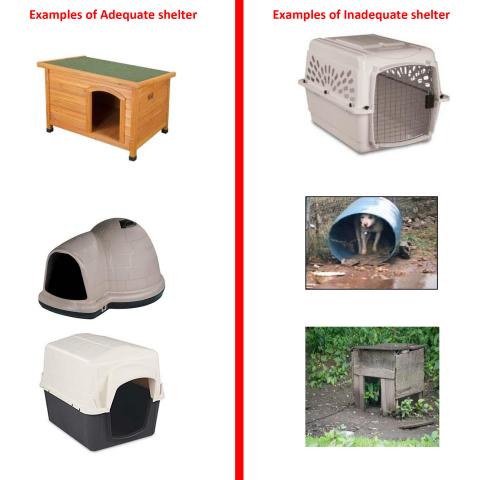Adequate Shelter Guide
Adequate shelter defined under Oregon State Statute ORS 167.310 (b) (A-G) is a barn, doghouse or other enclosed structure sufficient to protect a domestic animal from wind, rain, snow or sun that has adequate bedding to protect against cold and dampness and maintained to protect the domestic animal from weather and physical injury.
- “Adequate” Meets standard of law
- “Inadequate” fails to meet standard of Law
Download a printable copy:

- Summer Shelter: Shelter should be shaded. A doghouse in direct sun will not give heat relief.
- Winter Shelter: There should be insulation in the shelter: straw, cedar chips or other material that will not hold water and then freeze. Bedding such as straw and cedar chips should be changed every 2 weeks.
ADEQUATE SHELTER
Shelter should meet ALL of these conditions:
- Space is suitable for EACH animal appropriate for the species, age, condition, size and type of animal.
- Has adequate bedding: bedding of sufficient quantity and quality to permit a domestic animal to remain dry, and reasonably clean, and able to maintain a normal body temperature.
- Is safe and PROTECTS EACH animal from injury, rain, sleet, snow, hail AND direct sunlight.
- Protects from adverse effects of heat or cold AND physical suffering.
- Animals must be able to sit, stand, turn around, lie down, and have all normal body movements.
- Protects from impairment of health.
- Is properly lighted AND properly cleaned.
- Enables each animal to be clean and dry (except when detrimental to the species)
- For dogs and cats, provides a solid surface resting platform, pad, floor mat, or similar device that is large enough for the animal to lie in a normal manner.
- Can be contained in a sanitary manner.
INADEQUATE SHELTER
- Crawl spaces under buildings or parts of buildings, such as a deck, steps, or stoop.
- The space under a vehicle.
- The inside of a vehicle, if the manner or length of time the animal is kept in the vehicle is detrimental to the animal’s health or safety.
- Shelters made from cardboard or other materials that are easily degraded by the elements.
- Animal carriers or crates designed to provide temporary housing.
- Does not keep the animal clean and dry.
- Unlighted and or impairs health.
- Shelters with wire, chain-link, grid, or slat floors that allow the dog or cats feet to pass through the openings; (unless the domestic animal is a bird).
- Shelters surrounded by waste, debris, obstructions, or impediments that could adversely affect the animal’s health and cannot be maintained in a sanitary manner.
- Unlawful tethering (ORS 167.343) – Companion animals must not spend more than 10 hours a day on a chain or tether or more than 15 hours a day fixed to a trolley/cable runner.
Shelter for Community Cats
Are you caring for outdoor community cats? Ideas and detailed instructions for building temporary emergency shelters, and permanent winter shelters that meet requirements for adequate shelter are available from: